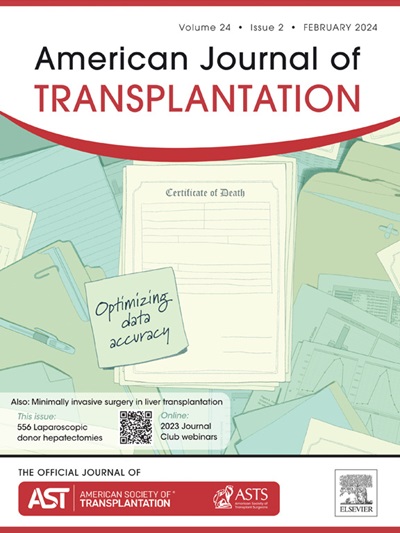电子鼻区分肺移植受者并发症的能力
IF 8.9
2区 医学
Q1 SURGERY
引用次数: 0
摘要
急性细胞排斥反应(ACR)和感染等并发症是导致慢性肺移植功能障碍(CLAD)的已知风险因素,影响肺移植(LTx)后患者和移植物的长期存活。区分并发症仍具有挑战性和时间敏感性,因此需要准确、快速的诊断方法。我们评估了使用电子鼻(eNose)进行呼气分析以区分肺移植受者(LTR)疑似并发症的 ACR、感染和机械并发症的能力。对疑似并发症并随后确诊的LTR患者使用电子鼻进行呼气分析。我们使用有监督的机器学习来评估 eNose 识别并发症的能力。接下来,我们确定了 eNose 测量在标准临床参数基础上的附加值。在 90 例 LTR 中,对疑似并发症进行了 161 次测量,其中 84 例确诊。电子鼻区分 ACR、感染和机械并发症的准确率为 74%,区分 ACR 和感染的准确率为 82%。将 eNose 测量与标准临床参数相结合,诊断准确率提高到 88%(p=0.0139),灵敏度为 94%,特异性为 80%。使用 eNose 技术进行呼气分析是一种很有前途的无创诊断方式,可用于区分 LTx 并发症,从而实现及时诊断和干预。本文章由计算机程序翻译,如有差异,请以英文原文为准。

The ability of an electronic nose to distinguish between complications in lung transplant recipients
Complications like acute cellular rejection (ACR) and infection are known risk factors for the development of chronic lung allograft dysfunction, impacting long-term patient and graft survival after lung transplantation (LTx). Differentiating between complications remains challenging and time-sensitive, highlighting the need for accurate and rapid diagnostic modalities. We assessed the ability of exhaled breath analysis using an electronic nose (eNose) to distinguish between ACR, infection, and mechanical complications in LTx recipients (LTR) presenting with suspected complications. LTR with suspected complications and subsequently proven diagnosis underwent exhaled breath analysis using an eNose. Supervised machine learning was used to assess the eNose’s ability to discriminate between complications. Next, we determined the added value of the eNose measurement on top of standard clinical parameters. In 90 LTR, 161 measurements were performed during suspected complications, with 84 proven diagnoses. The eNose could distinguish between ACR, infection, and mechanical complications with 74% accuracy, and ACR and infection with 82% accuracy. Combining eNose measurements with standard clinical parameters improved diagnostic accuracy to 88% (P =.0139), with 94% sensitivity and 80% specificity. Exhaled breath analysis using eNose technology is a promising, noninvasive, diagnostic modality for distinguishing LTx complications, enabling timely diagnosis and interventions.
求助全文
通过发布文献求助,成功后即可免费获取论文全文。
去求助
来源期刊
CiteScore
18.70
自引率
4.50%
发文量
346
审稿时长
26 days
期刊介绍:
The American Journal of Transplantation is a leading journal in the field of transplantation. It serves as a forum for debate and reassessment, an agent of change, and a major platform for promoting understanding, improving results, and advancing science. Published monthly, it provides an essential resource for researchers and clinicians worldwide.
The journal publishes original articles, case reports, invited reviews, letters to the editor, critical reviews, news features, consensus documents, and guidelines over 12 issues a year. It covers all major subject areas in transplantation, including thoracic (heart, lung), abdominal (kidney, liver, pancreas, islets), tissue and stem cell transplantation, organ and tissue donation and preservation, tissue injury, repair, inflammation, and aging, histocompatibility, drugs and pharmacology, graft survival, and prevention of graft dysfunction and failure. It also explores ethical and social issues in the field.

 求助内容:
求助内容: 应助结果提醒方式:
应助结果提醒方式:


